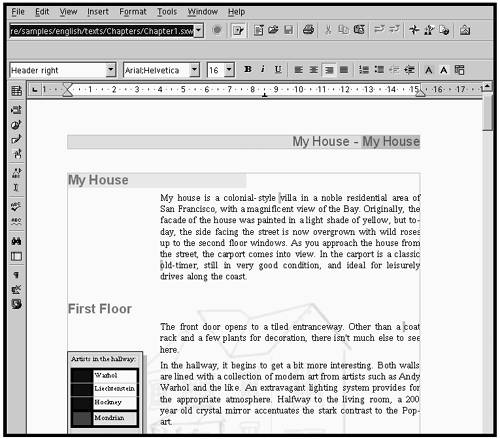Program Essentials
| It's is a full-featured office suite that you can use to create text documents and Web pages, spreadsheets, slide presentations, and drawings and images. Its three main distinguishing characteristics are that it handles (opens and creates) Microsoft Office formats, as well as nearly 200 other formats; its price is microscopic compared to Microsoft Office; and it runs on Linux, Lindows, and Solaris as well as Microsoft Windows . And for anyone who's experienced Microsoft's licensing fees and regulations, OpenOffice.org is a breath of fresh air on that front too. Applications and FeaturesThere are four main applications:
Built into some or all of the applications are the following features and add-ons:
OpenOffice.org 1.0.1 is the current release at the time this book was written. OpenOffice.org is pretty much the same as StarOffice; OpenOffice.org 1.0 corresponds roughly to StarOffice 6.0. OpenOffice.org and StarOffice started from the same piece of code. Since then, Sun has been working on StarOffice, and an organization of open source programmers, has been working on OpenOffice.org. So there are some differences between them, but they're basically the same program. Additional Release With New FeaturesMere hours before sending this book to print, build 643 was released. Key features include a macro recorder and native PDF. For more information, and to download build 643, see http://www.openoffice.org/dev_docs/source/643/release_notes.html. Participating in Creating OpenOffice.orgWhen was the last time you sent a Microsoft Word feature request to Bill Gates and got him to put it in? How You Can Get InvolvedOpenOffice.org is open source, which means anyone can develop and add features. If you want something in the software and you can code, then you can participate. You can also participate in the QA and documentation process, as well. Go to http://www.openoffice.org/contributing.html and http://www.openoffice.org/about.html to learn more. Learning About Newly Developed FeaturesSign up for the allfeatures@openoffice.org mailing list, at www.openoffice.org. Differences Between StarOffice and OpenOffice.orgStarOffice 6.0 is a commercial product aimed at organizations and consumers while OpenOffice.org 1.0 is aimed at users of free software, independent developers and the open source community. There is an ongoing partnership between Sun and the Open Office community, to develop OpenOffice.org. Sun pays some of the programmers as well as for the www.openoffice.org site. Improvements to OpenOffice.org typically are incorporated into StarOffice where possible, and vice versa, where possible. Figure 1-1 on page 9 shows the same document in StarOffice and in OpenOffice.org. The key difference is that while the features are generally the same, anything that's a third-party addon in StarOffice, such as the Adabas database or the WordPerfect filter, is missing or different in OpenOffice.org. Figure 1-1. The same document in StarOffice and OpenOffice.org Note The StarOffice spellchecker is an addon feature, created by a third party. Since this feature couldn't be licensed under open source, the OpenOffice.org spellchecker is different. You might notice some differences if you use both programs. The source code available at OpenOffice.org does not consist of all of the StarOffice code. Usually, the reason for this is that Sun pays to license third party code to include in StarOffice that which it does not have permission to make available in OpenOffice.org. Items in StarOffice but not in OpenOffice.org include:
WordPerfectStarOffice 6 for Windows has WordPerfect filters; these are proprietary to a third party so could not be included in the open source product. Star Office 6.0 for UNIX does not have WordPerfect filters included with it. However, a libwpd-based filter has been written for OpenOffice.org's Writer application. Screenshots and downloads available at http://libwpd.sf.net.libwpd is a generic library for importing (and exporting, eventually) WordPerfect files into another application. You'll also see occasional differences in the layout of windows, such as where a certain checkbox option appears, but usually not differences in the options available in a window. All development on platforms beyond Solaris, Linux, and Windows is being done by OpenOffice.org. You can find out about features on allfeatures@openoffice.org; to sign up for this or other mailing lists, go to http://www.openoffice.org/mail_list.html. OpenOffice.org on Other PlatformsPorting projectsswitching OpenOffice.org over to work with other platformshave been going on for a while. The one receiving the most attention at the time this book was written is the Mac OSX porting project. In May 2002 OpenOffice.org released a pre-alpha "Developer Build" for OpenOffice.org on Mac OSX., targeted at developers familiar with developing for the Mac OS X platform.At that time, the download was available at http://porting.openoffice.org/mac/ooo-osx_downloads.html It's also on the CD included with this book. For information on other porting projects, go to http://porting.openoffice.org/ OpenOffice.org Templates and Other ExtrasAll the templates, etc. in StarOffice don't come with OpenOffice.org. However, Travis Bauer's Web site, www.ooextras.org, has what might be called a plethora of templates and other "extras." The OpenOffice.org team has also put together a separate set of templates. They're on the CD included with this book. You can see all template links, including templates created by the authors, at www.getopenoffice.org/templates.html Reference Documentation: API and DTDThe OpenOffice.org API is available through www.openoffice.org. Contact that site for information about joining an OpenOffice.org project. http://www.openoffice.org/about.html http://www.openoffice.org/contributing.html To get the DTD, the definition of the document formats, go to http://xml.openoffice.org. Go to the Documentation and Resources section, then follow the link to the DTD. Developers should also go to http://api.openoffice.org, in particular: http://api.openoffice.org/source/browse/api/devmanual/ |
EAN: 2147483647
Pages: 407



